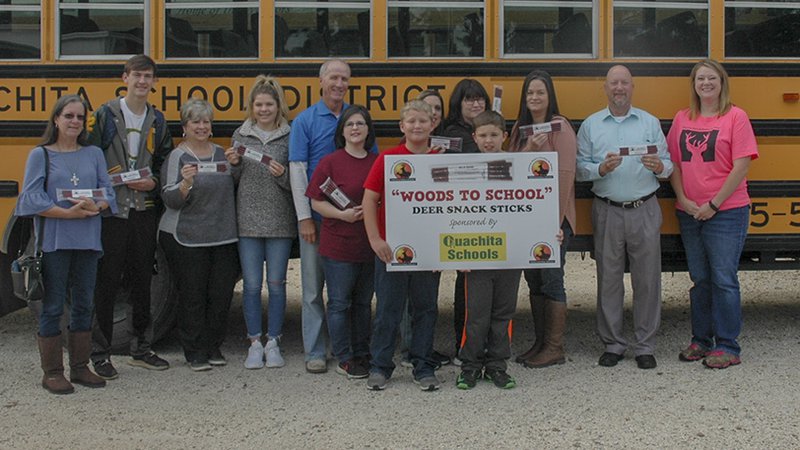Healthy Snack Stick Program Will Reach 12,000 Children
BY Jim Harris
ON 10-24-2018

Oct. 24, 2018
Jim Harris
Managing Editor Arkansas Wildlife Magazine
LITTLE ROCK – One of the new projects of Arkansas Hunters Feeding the Hungry is bringing snack sticks of deer meat and pork to thousands of young students and several of the state’s schools. Arkansas Game and Fish Commissioners learned about it last week and found it worthy enough to contribute grant money totaling $100,000 over the next four years to help the endeavor.
Ronnie Ritter, executive director of Arkansas Hunters Feeding the Hungry, began a pilot program last May to create the packaged food snacks, called the Woods to School Snack-Stick Program, and it’s taken off this year, beginning with an urban deer bowhunt in Hot Springs Village that harvested 66 deer.
“It took several months to get here,” said Ritter, who credited the program name to AGFC Assistant Director Chris Colclasure. “We’ve been working on this a year or so. I’ve actually been thinking for years, there’s got to be a way … I knew people made beef snack sticks, so why don’t we do deer snack sticks?
“We wanted to help kids in local schools because a lot of kids go home on the weekends and don’t have food to eat – one, because the family can’t afford it and, two, because of the home situation they may be in where parents may be working or are not there.”
Traditionally, the first deer taken in the Hot Springs Village urban deer hunt goes to Arkansas Hunters Feeding the Hungry. Ritter worked it out with the Village and the AGFC to donate more deer if hunters chose to, and 66 deer went into the program. Each deer first was tested for chronic wasting disease before then being sent to a processor south of St. Louis to be turned into snack sticks. The makeup of the snack sticks is 65 percent deer meat and about 35 percent pork (to add fat to the very lean meat of deer), plus a variety of spices such as garlic. Also included are ingredients needed to make the snacks shelf-stable.
“A lot of processors around here can make the snack sticks already, but nobody close to us does the shelf-stable snack sticks, they would have to be refrigerated,” Ritter said. “These sticks can last nine months without refrigeration.”
Ritter said he hopes a local processor will come aboard in the not-too-distant future with the ability to make the snacks shelf-stable. In the meantime, Stonie’s Sausage Shop in Perryville, Missouri, a USDA-certified processor, handles the Arkansas order, as well as processing for a similar program involving the Missouri Department of Conservation dubbed “Share the Harvest.”
The Arkansas program has enrolled eight school districts – Jonesboro, Norfork, Highland, Hot Springs, Ouachita, Cutter-Morning Star, Arkadelphia and Sheridan – along with the Northeast Arkansas Foodbank.
At the Thursday, Oct. 18, the AGFC commissioners OK’d the grant of $100,000 to Arkansas Hunters Feeding the Hungry that will cover the next four years of the program, Ritter said.
Ritter said he looked at various school needs for the first recipients of the snack sticks, going by a list from the Arkansas Department of Education of schools offering free and reduced meals. “We tried to take those in the top tier and also where we could get funding to do it,” he said. “We got funding mostly through grants and private donations in the various districts. Express Boats in Hot Springs is a main sponsor, along with the Ross Foundation in Arkadelphia, Shelter Insurance, Walmart, Crossgate Church and several local churches in those school districts. The schools help gather donations, too.”
The 66 deer taken by bowhunting in Hot Springs Village provide enough meat to produce 8,000 vacuum-sealed packages, each containing four snack sticks. Ritter said he has 12,000 packages committed to go out to the current list of schools in the program this year, so he’s looking for more deer taken by bowhunters. It takes about a month for a deer to be processed after it’s tested, Ritter said. Then they are shipped to the school districts as part of their backpack snack programs.
“In some of these weekend backpack programs, they may be putting in chips and stuff, but no protein. When we started introducing it in the pilot program, the kids loved it,” Ritter said. While deer snack sticks may look like a snack food found at a convenience store, Ritter adds, “They are not real greasy. They’re very good and they’re healthy to eat.”
He added, “We’re still in the development of this program. But we did a lot with the AGFC’s Family and Community Fishing Program events already. We let them take some of the sticks out at their events and slice them up, and the kids kept coming back for more.’ We did the pilot program roll-out at Waldron, Nashville and Sheridan.”
For more information or to inquire about being added to the school program, call Ritter at 501-282-0006 or email him at ronnieritter@yahoo.com.
Recent News
Subscribe to Our Weekly Newsletter E-mails
Don’t miss another issue. Sign up now to receive the AGFC Wildlife Weekly Newsletter in your mailbox every Wednesday afternoon (Waterfowl Reports are published weekly during waterfowl season and periodically outside the season). Fishing Reports arrive on Thursdays. Fill in the following fields and hit submit. Thanks, and welcome!


